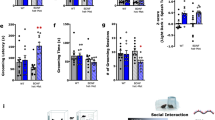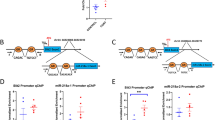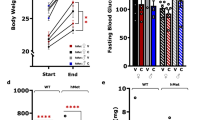Abstract
Paternal stress exposure-induced high corticosterone (CORT) levels may contribute to depression in offspring. Clinical studies disclose the association of depressive symptoms in fathers with their adolescent offspring. However, there is limited information regarding the intervention for intergenerational inheritance of depression. In this study we evaluated the intervention of cinnamaldehyde, a major constituent of Chinese herb cinnamon bark, for intergenerational inheritance of depression in CORT- and CMS-induced mouse models of depression. Depressive-like behaviors were induced in male mice by injection of CORT (20 mg·kg−1·d−1, sc) for 6 weeks or by chronic mild stress (CMS) for 6 weeks. We showed that co-administration of cinnamaldehyde (10, 20, or 40 mg·kg−1·d−1, ig) for 6 weeks in F0 males prevented the depressive-like phenotypes of F1 male offspring. In addition, co-administration of cinnamaldehyde (20 mg·kg−1·d−1, ig) for 4 weeks significantly ameliorated depressive-like behaviors of chronic variable stress (CVS)-stimulated F1 offspring born to CMS mice. Notably, cinnamaldehyde had no reproductive toxicity, while positive drug fluoxetine showed remarkable reproductive toxicity. We revealed that CMS and CORT significantly reduced testis glucocorticoid receptor (GR) expression, and increased testis and sperm miR-190b expression in F0 depressive-like models. Moreover, pre-miR-190b expression was upregulated in testis of F0 males. The amount of GR on miR-190b promoter regions was decreased in testis of CORT-stimulated F0 males. Cinnamaldehyde administration reversed CORT-induced GR reduction in testis, miR-190b upregulation in testis and sperm, pre-miR-190b upregulation in testis, and the amount of GR on miR-190b promoter regions of F0 males. In miR-190b-transfected Neuro 2a (N2a) cells, we demonstrated that miR-190b might directly bind to the 3′-UTR of brain-derived neurotrophic factor (BDNF). In the hippocampus of F1 males of CORT- or CMS-induced depressive-like models, increased miR-190b expression was accompanied by reduced BDNF and GR, which were ameliorated by cinnamaldehyde. In conclusion, cinnamaldehyde is a potential intervening agent for intergenerational inheritance of depression, probably by regulating GR/miR-190b/BDNF pathway.
Similar content being viewed by others
Log in or create a free account to read this content
Gain free access to this article, as well as selected content from this journal and more on nature.com
or
References
Duman RS, Aghajanian GK, Sanacora G, Krystal JH. Synaptic plasticity and depression: new insights from stress and rapid-acting antidepressants. Nat Med. 2016;22:238–49.
Gapp K, Jawaid A, Sarkies P, Bohacek J, Pelczar P, Prados J, et al. Implication of sperm RNAs in transgenerational inheritance of the effects of early trauma in mice. Nat Neurosci. 2014;17:667–9.
Bohacek J, Mansuy IM. A guide to designing germline-dependent epigenetic inheritance experiments in mammals. Nat Methods. 2017;14:243–9.
Lewis G, Neary M, Polek E, Flouri E, Lewis G. The association between paternal and adolescent depressive symptoms: evidence from two population-based cohorts. Lancet Psychiatry. 2017;4:920–6.
Stein A, Pearson RM, Goodman SH, Rapa E, Rahman A, McCallum M, et al. Effects of perinatal mental disorders on the fetus and child. Lancet. 2014;384:1800–19.
Yehuda R, Daskalakis NP, Lehrner A, Desarnaud F, Bader HN, Makotkine I, et al. Influences of maternal and paternal PTSD on epigenetic regulation of the glucocorticoid receptor gene in Holocaust survivor offspring. Am J Psychiatry. 2014;171:872–80.
Petropoulos S, Matthews SG, Szyf M. Adult glucocorticoid exposure leads to transcriptional and DNA methylation changes in nuclear steroid receptors in the hippocampus and kidney of mouse male offspring. Biol Reprod. 2014;90:43.
Wang Y, Chen ZP, Hu H, Lei J, Zhou Z, Yao B, et al. Sperm microRNAs confer depression susceptibility to offspring. Sci Adv. 2021;7:eabd7605.
Short AK, Fennell KA, Perreau VM, Fox A, O’Bryan MK, Kim JH, et al. Elevated paternal glucocorticoid exposure alters the small noncoding RNA profile in sperm and modifies anxiety and depressive phenotypes in the offspring. Transl Psychiatry. 2016;6:e837.
Pietrzykowski AZ, Spijker S. Impulsivity and comorbid traits: a multi-step approach for finding putative responsible microRNAs in the amygdala. Front Neurosci. 2014;8:389.
Xiong GJ, Yang Y, Cao J, Mao RR, Xu L. Fluoxetine treatment reverses the intergenerational impact of maternal separation on fear and anxiety behaviors. Neuropharmacology. 2015;92:1–7.
Zaidan H, Galiani D, Gaisler-Salomon I. Pre-reproductive stress in adolescent female rats alters oocyte microRNA expression and offspring phenotypes: pharmacological interventions and putative mechanisms. Transl Psychiatry. 2021;11:113.
Zada W, Zeeshan S, Bhatti HA, Mahmood W, Rauf K, Abbas G. Cinnamomum cassia: an implication of serotonin reuptake inhibition in animal models of depression. Nat Prod Res. 2016;30:1212–4.
Goswami SK, Inamdar MN, Jamwal R, Dethe S. Effect of Cinnamomum cassia methanol extract and sildenafil on arginase and sexual function of young male Wistar rats. J Sex Med. 2014;11:1475–83.
Blevins SM, Leyva MJ, Brown J, Wright J, Scofield RH, Aston CE. Effect of cinnamon on glucose and lipid levels in non insulin-dependent type 2 diabetes. Diabetes Care. 2007;30:2236–7.
Iqbal S, Jabeen F, Peng C, Ijaz MU, Chaudhry AS. Cinnamomum cassia ameliorates Ni-NPs-induced liver and kidney damage in male Sprague Dawley rats. Hum Exp Toxicol. 2020;39:1565–81.
Bae WY, Choi JS, Jeong JW. The neuroprotective effects of cinnamic aldehyde in an MPTP mouse model of Parkinson’s disease. Int J Mol Sci. 2018;19:551. https://doi.org/10.3390/ijms19020551.
Lv C, Yuan X, Zeng HW, Liu RH, Zhang WD. Protective effect of cinnamaldehyde against glutamate-induced oxidative stress and apoptosis in PC12 cells. Eur J Pharmacol. 2017;815:487–94.
Zhang L, Zhang Z, Fu Y, Yang P, Qin Z, Chen Y, et al. Trans-cinnamaldehyde improves memory impairment by blocking microglial activation through the destabilization of iNOS mRNA in mice challenged with lipopolysaccharide. Neuropharmacology. 2016;110:503–18.
Mateen S, Shahzad S, Ahmad S, Naeem SS, Khalid S, Akhtar K, et al. Cinnamaldehyde and eugenol attenuates collagen-induced arthritis via reduction of free radicals and pro-inflammatory cytokines. Phytomedicine. 2019;53:70–8.
Chen BJ, Fu CS, Li GH, Wang XN, Lou HX, Ren DM, et al. Cinnamaldehyde analogues as potential therapeutic agents. Mini Rev Med Chem. 2017;17:33–43.
Buglak NE, Jiang W, Bahnson ESM. Cinnamic aldehyde inhibits vascular smooth muscle cell proliferation and neointimal hyperplasia in Zucker Diabetic Fatty rats. Redox Biol. 2018;19:166–78.
Yao Y, Huang HY, Yang YX, Guo JY. Cinnamic aldehyde treatment alleviates chronic unexpected stress-induced depressive-like behaviors via targeting cyclooxygenase-2 in mid-aged rats. J Ethnopharmacol. 2015;162:97–103.
Arloth J, Bogdan R, Weber P, Frishman G, Menke A, Wagner KV, et al. Genetic differences in the immediate transcriptome response to stress predict risk-related brain function and psychiatric disorders. Neuron. 2015;86:1189–202.
Autry AE, Adachi M, Nosyreva E, Na ES, Los MF, Cheng PF, et al. NMDA receptor blockade at rest triggers rapid behavioural antidepressant responses. Nature. 2011;475:91–5.
Duman RS, Aghajanian GK. Synaptic dysfunction in depression: potential therapeutic targets. Science. 2012;338:68–72.
Revest JM, Le Roux A, Roullot-Lacarriere V, Kaouane N, Vallee M, Kasanetz F, et al. BDNF-TrkB signaling through Erk1/2 MAPK phosphorylation mediates the enhancement of fear memory induced by glucocorticoids. Mol Psychiatry. 2014;19:1001–9.
Li J, Liu T, Wang L, Guo X, Xu T, Wu L, et al. Antihyperglycemic and antihyperlipidemic action of cinnamaldehyde in C57BLKS/J db/db mice. J Tradit Chin Med. 2012;32:446–52.
Zhao J, Zhang X, Dong L, Wen Y, Zheng X, Zhang C, et al. Cinnamaldehyde inhibits inflammation and brain damage in a mouse model of permanent cerebral ischaemia. Br J Pharmacol. 2015;172:5009–23.
Kang LL, Zhang DM, Ma CH, Zhang JH, Jia KK, Liu JH, et al. Cinnamaldehyde and allopurinol reduce fructose-induced cardiac inflammation and fibrosis by attenuating CD36-mediated TLR4/6-IRAK4/1 signaling to suppress NLRP3 inflammasome activation. Sci Rep. 2016;6:27460.
Apazoglou K, Farley S, Gorgievski V, Belzeaux R, Lopez JP, Grenier J, et al. Antidepressive effects of targeting ELK-1 signal transduction. Nat Med. 2018;24:591–7.
Tye KM, Mirzabekov JJ, Warden MR, Ferenczi EA, Tsai HC, Finkelstein J, et al. Dopamine neurons modulate neural encoding and expression of depression-related behaviour. Nature. 2013;493:537–41.
Jasarevic E, Howard CD, Morrison K, Misic A, Weinkopff T, Scott P, et al. The maternal vaginal microbiome partially mediates the effects of prenatal stress on offspring gut and hypothalamus. Nat Neurosci. 2018;21:1061–71.
Pena CJ, Kronman HG, Walker DM, Cates HM, Bagot RC, Purushothaman I, et al. Early life stress confers lifelong stress susceptibility in mice via ventral tegmental area OTX2. Science. 2017;356:1185–8.
Mathelier A, Fornes O, Arenillas DJ, Chen CY, Denay G, Lee J, et al. JASPAR 2016: a major expansion and update of the open-access database of transcription factor binding profiles. Nucleic Acids Res. 2016;44:D110–5.
Lee C, Huang CH. LASAGNA-Search 2.0: integrated transcription factor binding site search and visualization in a browser. Bioinformatics. 2014;30:1923–5.
Sun W, Li J, Zhou L, Han J, Liu R, Zhang H, et al. The c-Myc/miR-27b-3p/ATG10 regulatory axis regulates chemoresistance in colorectal cancer. Theranostics. 2020;10:1981–96.
Gao Z, Zhou L, Hua S, Wu H, Luo L, Li L, et al. miR-24-3p promotes colon cancer progression by targeting ING1. Signal Transduct Target Ther. 2020;5:171.
Alzahrani HA. Sister chromatid exchanges and sperm abnormalities produced by antidepressant drug fluoxetine in mouse treated in vivo. Eur Rev Med Pharmacol Sci. 2012;16:2154–61.
Ayala ME, Gonzáles A, Olivarez RM, Aragón-Martínez A. Fluoxetine treatment of prepubertal male rats uniformly diminishes sex hormone levels and, in a subpopulation of animals, negatively affects sperm quality. Reprod Fertil Dev. 2018;30:1329–41.
Bataineh HN, Daradka T. Effects of long-term use of fluoxetine on fertility parameters in adult male rats. Neuro Endocrinol Lett. 2007;28:321–5.
Bezerra MS, Martins ABM, Trajano FMG, Pontes THA, Gomes L, Gavioli EC, et al. Fluoxetine and sertraline effects on rat distal cauda epididymis contraction, sperm count and sperm transit time trough epididymis. Eur J Pharmacol. 2019;865:172774.
Karimipour M, Ahmadi A, Zirak Javanmard M, Jafari A, Mohebi M, Hosseinalipour E. The effects of exposure to fluoxetine during lactation on testicular tissue and sperm parameters in mice offspring. Vet Res Forum. 2020;11:35–42.
Roboon J, Nudmamud-Thanoi S, Thanos S. Recovery effect of pre-germinated brown rice on the alteration of sperm quality, testicular structure and androgen receptor expression in rat model of depression. Andrologia. 2017;49:1–10.
Sakr HF, Abbas AM, Elsamanoudy AZ, Ghoneim FM. Effect of fluoxetine and resveratrol on testicular functions and oxidative stress in a rat model of chronic mild stress-induced depression. J Physiol Pharmacol. 2015;66:515–27.
Cryan JF, Holmes A. The ascent of mouse: advances in modelling human depression and anxiety. Nat Rev Drug Discov. 2005;4:775–90.
Krishnan V, Han MH, Graham DL, Berton O, Renthal W, Russo SJ, et al. Molecular adaptations underlying susceptibility and resistance to social defeat in brain reward regions. Cell. 2007;131:391–404.
Gourley SL, Kiraly DD, Howell JL, Olausson P, Taylor JR. Acute hippocampal brain-derived neurotrophic factor restores motivational and forced swim performance after corticosterone. Biol Psychiatry. 2008;64:884–90.
Muller MB, Holsboer F. Mice with mutations in the HPA-system as models for symptoms of depression. Biol Psychiatry. 2006;59:1104–15.
Chen Y, Ma Y, Ma W. Pharmacokinetics and bioavailability of cinnamic acid after oral administration of Ramulus Cinnamomi in rats. Eur J Drug Metab Pharmacokinet. 2009;34:51–6.
Patra K, Bose S, Sarkar S, Rakshit J, Jana S, Mukherjee A, et al. Amelioration of cyclophosphamide induced myelosuppression and oxidative stress by cinnamic acid. Chem Biol Interact. 2012;195:231–9.
Wu Y, Wang M, Yang T, Qin L, Hu Y, Zhao D, et al. Cinnamic acid ameliorates nonalcoholic fatty liver disease by suppressing hepatic lipogenesis and promoting fatty acid oxidation. Evid Based Complement Altern Med. 2021;2021:9561613.
Taner G, Ozkan Vardar D, Aydin S, Aytac Z, Basaran A, Basaran N. Use of in vitro assays to assess the potential cytotoxic, genotoxic and antigenotoxic effects of vanillic and cinnamic acid. Drug Chem Toxicol. 2017;40:183–90.
Yuce A, Turk G, Ceribasi S, Guvenc M, Ciftci M, Sonmez M, et al. Effectiveness of cinnamon (Cinnamomum zeylanicum) bark oil in the prevention of carbon tetrachloride-induced damages on the male reproductive system. Andrologia. 2014;46:263–72.
Onder A, Yilmaz-Oral D, Jerkovic I, Akdemir AO, Gur S. Evaluation of relaxant responses properties of cinnamon essential oil and its major component, cinnamaldehyde on human and rat corpus cavernosum. Int Braz J Urol. 2019;45:1033–42.
Kurishita A, Ihara T. Inhibitory effects of cobalt chloride and cinnamaldehyde on 5-azacytidine-induced digital malformations in rats. Teratology. 1990;41:161–6.
Mantovani A, Stazi AV, Macri C, Ricciardi C, Piccioni A, Badellino E. Pre-natal (segment II) toxicity study of cinnamic aldehyde in the Sprague-Dawley rat. Food Chem Toxicol. 1989;27:781–6.
Hosni AA, Abdel-Moneim AA, Abdel-Reheim ES, Mohamed SM, Helmy H. Cinnamaldehyde potentially attenuates gestational hyperglycemia in rats through modulation of PPARgamma, proinflammatory cytokines and oxidative stress. Biomed Pharmacother. 2017;88:52–60.
Pang TYC, Short AK, Bredy TW, Hannan AJ. Transgenerational paternal transmission of acquired traits: stress-induced modification of the sperm regulatory transcriptome and offspring phenotypes. Curr Opin Behav Sci. 2017;14:140–7.
Klengel T, Dias BG, Ressler KJ. Models of intergenerational and transgenerational transmission of risk for psychopathology in mice. Neuropsychopharmacology. 2016;41:219–31.
John S, Sabo PJ, Thurman RE, Sung MH, Biddie SC, Johnson TA, et al. Chromatin accessibility pre-determines glucocorticoid receptor binding patterns. Nat Genet. 2011;43:264–8.
Vockley CM, D’Ippolito AM, McDowell IC, Majoros WH, Safi A, Song L, et al. Direct GR binding sites potentiate clusters of TF binding across the human genome. Cell. 2016;166:1269–81 e19.
Gertz J, Savic D, Varley KE, Partridge EC, Safi A, Jain P, et al. Distinct properties of cell-type-specific and shared transcription factor binding sites. Mol Cell. 2013;52:25–36.
Wu PH, Fu Y, Cecchini K, Ozata DM, Arif A, Yu T, et al. The evolutionarily conserved piRNA-producing locus pi6 is required for male mouse fertility. Nat Genet. 2020;52:728–39.
Sharma U, Conine CC, Shea JM, Boskovic A, Derr AG, Bing XY, et al. Biogenesis and function of tRNA fragments during sperm maturation and fertilization in mammals. Science. 2016;351:391–6.
Burton NO, Burkhart KB, Kennedy S. Nuclear RNAi maintains heritable gene silencing in Caenorhabditis elegans. Proc Natl Acad Sci USA. 2011;108:19683–8.
Gu SG, Pak J, Guang S, Maniar JM, Kennedy S, Fire A. Amplification of siRNA in Caenorhabditis elegans generates a transgenerational sequence-targeted histone H3 lysine 9 methylation footprint. Nat Genet. 2012;44:157–64.
Liu WM, Pang RT, Chiu PC, Wong BP, Lao K, Lee KF, et al. Sperm-borne microRNA-34c is required for the first cleavage division in mouse. Proc Natl Acad Sci USA. 2012;109:490–4.
Chen Q, Yan M, Cao Z, Li X, Zhang Y, Shi J, et al. Sperm tsRNAs contribute to intergenerational inheritance of an acquired metabolic disorder. Science. 2016;351:397–400.
Zhang F, Zhang Y, Lv X, Xu B, Zhang H, Yan J, et al. Evolution of an X-Linked miRNA family predominantly expressed in mammalian male germ cells. Mol Biol Evol. 2019;36:663–78.
Zhang Y, Tang C, Yu T, Zhang R, Zheng H, Yan W. MicroRNAs control mRNA fate by compartmentalization based on 3’ UTR length in male germ cells. Genome Biol. 2017;18:105.
Yang Q, Lin J, Liu M, Li R, Tian B, Zhang X, et al. Highly sensitive sequencing reveals dynamic modifications and activities of small RNAs in mouse oocytes and early embryos. Sci Adv. 2016;2:e1501482.
Koo JW, Chaudhury D, Han MH, Nestler EJ. Role of mesolimbic brain-derived neurotrophic factor in depression. Biol Psychiatry. 2019;86:738–48.
Castren E, Hen R. Neuronal plasticity and antidepressant actions. Trends Neurosci. 2013;36:259–67.
Zhao H, Yuan J, Yang Q, Xie Y, Cao W, Wang S. Cinnamaldehyde in a novel intravenous submicrometer emulsion: pharmacokinetics, tissue distribution, antitumor efficacy, and toxicity. J Agric Food Chem. 2015;63:6386–92.
Acknowledgements
This work was supported by the Fundamental Research Funds for the Central Universities.
Author information
Authors and Affiliations
Contributions
LDK and YP supervised and conceptualized the study. LDK, YP, and ZYG prepared the manuscript. ZYG, TYC, TTY, LPZ, SJZ, and XYG performed the experiments. All authors have read and approved the final manuscript.
Corresponding authors
Ethics declarations
Competing interests
The authors declare no competing interests.
Supplementary information
Rights and permissions
About this article
Cite this article
Gao, Zy., Chen, Ty., Yu, Tt. et al. Cinnamaldehyde prevents intergenerational effect of paternal depression in mice via regulating GR/miR-190b/BDNF pathway. Acta Pharmacol Sin 43, 1955–1969 (2022). https://doi.org/10.1038/s41401-021-00831-0
Received:
Accepted:
Published:
Issue date:
DOI: https://doi.org/10.1038/s41401-021-00831-0
Keywords
This article is cited by
-
Dysregulated miR-124 mediates impaired social memory behavior caused by paternal early social isolation
Translational Psychiatry (2024)



